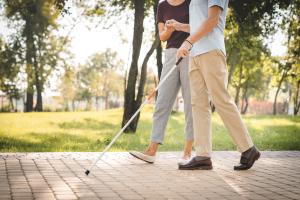
الجامعة تهيئ مناخاً داعماً لتعليم ذوي الإعاقة
لدى شخص واحد من كل سبعة أشخاص حول العالم شكل من أشكال الإعاقة الذهنية أو الجسدية وذلك وفقاً لمنظمة الأمم المتحدة. يعيش نحو 80% من الأشخاص ذوي الإعاقة في الدول النامية بموارد ورعاية طبية محدودة. وفي خطوة لتمكين الأشخاص ذوي الإعاقة وزيادة التوعية في هذا الشأن، خصصت منظمة الأمم المتحدة يوم 3 ديسمبر ليكون اليوم الدولي للأشخاص ذوي الإعاقة. يعد موضوع عام 2015: انضمام الجميع: وصول وتمكين الناس من جميع القدرات.
وفي مصر، لدى الجامعة الأمريكية بالقاهرة بعض من أفضل المرافق والموارد لتهيئة المناخ العام للطلاب ذوي الإعاقة، هذا وتدأب الجامعة على تحسين تلك المرافق والموارد كل عام.
تقدم الجامعة تكنولوجيا تكيفية والتي تتضمن برمجيات ومكونات كمبيوتر مبتكرة لمساعدة الطلاب ضعاف البصر، وهما تكنولوجيا Job Access with Speech (JAWS)، التي تعد قارئ شاشة يقوم بتحويل النص الموجود على الشاشة إلى صوت اصطناعي، وتكنولوجيا Kurzweil 1000، التي تُستخدم في ترقيم مواد الطباعة مثل كتب المكتبة أو المقالات، أو الفروض الدراسية والاختبارات إلى صيغة تتمكن تكنولوجيا JAWS من قراءتها. هذا بالإضافة إلى ماكينة طباعة برايل التي تقوم بطباعة الكتب الإلكترونية، ووثائق PDF، والنصوص باللغة العربية بطريقة برايل. وهناك أيضاً Braille Note Display، الذي يعد جهاز محمول لتدوين الملاحظات بطريقة برايل حيث يتمكن الطلاب من استخدامه داخل الفصل. كما يوجد جهاز Plextalk، وهو جهاز صغير محمول لتسجيلات الصوتية أثناء المحاضرات.
في الوقت الحالي، يستخدم سبعة طلاب، من بينهم طالبين بالدراسات العليا، هذه التكنولوجيا لدراستهم بالجامعة التي تتراوح من الفلسفة والعلوم السياسية إلى الاقتصاد. تشير مروة منصور، مدير مساعد للعمليات بالخدمات التكنولوجية الأكاديمية بالجامعة، إلى ان هناك حاجة لتواجد تكنولوجيات متعددة لتهيئة الطلاب من الخلفيات المختلفة. تقول منصور "يتعلم ويُدرب بعض الطلاب على استخدام طريقة برايل، البعض منهم يعرفون كيفية استخدام تكنولوجيا JAWS بشكل جيد للغاية، والبعض الآخر يعتمد على التسجيلات فقط. نحن نعلم الطلاب كيف يستخدمون جميع التكنولوجيات المتاحة لدينا هنا بالجامعة."
يتم تركيب البرنامج الخاص بتكنولوجيا JAWS بالمجان على أجهزة الكمبيوتر المحمولة الخاصة بالطلاب ضعاف البصر أثناء فترة دراستهم هنا بالجامعة، ومع ذلك هناك للحصول على المزيد من التراخيص للطلاب الجدد. ومن أجل تقديم دعم أكبر للأشخاص ذوي الإعاقة، تعتزم الجامعة الحصول على عدسات مكبرة محمولة كي يستخدمها الطلاب ضعاف البصر داخل الفصل والاستثمار في الحصول على تكنولوجيا المسح المتقدمة لتحويل الوثائق المكتوبة إلى ملفات رقمية، والتي يمكن بدورها تحويلها إلى ملفات صوتية أو كتابة بطريقة برايل. لدى الخدمات التكنولوجية الأكاديمية بالجامعة مسئول غير متفرغ، يُدعى أحمد عبد التواب، للعمل مع الطلاب ضعاف البصر، حيث يقوم بتدريب الطلاب على استخدام برنامج JAWS ويساعدهم في مسح وطباعة الوثائق، وتركيب وإعداد البرامج على أجهزة الكمبيوتر الخاصة بهم. ومع ذلك، وحيث أن هناك طلباً متزايداً للحصول على مثل هذه الخدمات، تأمل الخدمات التكنولوجية الأكاديمية بالجامعة لتوظيف مسئول آخر لمساعدة الطلاب على استخدام هذه التكنولوجيا.
فضلاً عن ذلك، قام مركز الرياضة بالجامعة بتطوير حمام السباحة الخاص بالجامعة لضمان وجود وسيلة سهلة تسمح للأشخاص ذوي الإعاقة بالنزول والخروج من حمام السباحة، وذلك عن طريق تثبيت سلم منحدر في حمام سباحة بول هانون بالمركز الرياضي. تقول لويز برتيني، مدير الرياضات المائية بالجامعة، "إن هدفنا أن نقوم بخدمة جميع أفراد مجتمع الجامعة والسماح لذوي الاحتياجات الخاصة بسهولة استخدام حمام السباحة."
فقد تم تصميم الحرم الجامعي بالقاهرة الجديدة بشكل يناسب استخدام الأشخاص ذوي الإعاقة. فيمكن استخدام الكراسي المتحركة بجميع المناطق بالحرم الجامعي، كما تتوفر عربات الجولف الصغيرة للتنقل في جميع أنحاء الحرم الجامعي من خلال ترتيب مسبق.
كما حصلت الجامعة مؤخراً على هبة لتأسيس صندوق إسماعيل للطلاب الذين يعانون من صعوبات التعلم، لذا تمكن مكتب دعم الطلاب من مد خدماته لكل الطلاب بشكل أكبر لأن ليس كل الطلاب لديهم إعاقات واضحة للآخرين. تقول ألكسندرا جازيز، المدير المساعد لخدمات ذوي الإعاقة في مكتب دعم الطلاب، "إن صعوبات التعلم هي إعاقة خفية، فالطلاب ذوي صعوبات التعلم لا يحتاجون إلى الدعم الأكاديمي فحسب بل أيضاً للدعم الاجتماعي والشخصي." تشمل صعوبات التعلم اضطرابات مثل عسر الكتابة والقراءة، فضلاً عن اضطراب نقص الانتباه وفرط النشاط واضطراب نقص الانتباه.
كما سيكون متاحاً الآن للطلاب طبيب نفسي خبير في صعوبات التعلم، فضلاً عن متخصص بالتقييم لتقييم الطلاب، وتقديم توصيات المساعدة في وضع خطة مفصلة، بما في ذلك الخطوات نحو الأهداف الشخصية والأكاديمية والاجتماعية.
تقول جازيز "تعد الجامعة الأمريكية بالقاهرة واحدة من الجامعات الأولى في الشرق الأوسط التي يوجد لديها مكتب مخصص للطلاب ذوي الإعاقة. نرى الآن أن الجامعات الأخرى في مصر تتطلع إلى الجامعة الأمريكية بالقاهرة كمثال ويعترفون بأن هناك طلاب ذوي إعاقة لديهم ويحاولون معرفة ما يمكن القيام به لمساعدة الطلاب في مستقبلهم الأكاديمي إن هدفنا هو خلق بيئة للحرم الجامعي يتم النظر بها للطلاب على أساس القدرة بدلاً من العجز ".




